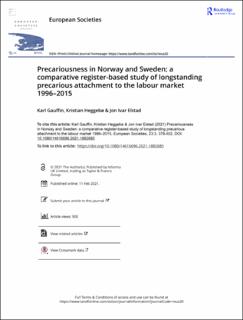| dc.contributor.author | Gauffin, Karl | |
| dc.contributor.author | Heggebø, Kristian | |
| dc.contributor.author | Elstad, Jon Ivar | |
| dc.coverage.spatial | Norway | en_US |
| dc.date.accessioned | 2022-03-28T09:37:15Z | |
| dc.date.available | 2022-03-28T09:37:15Z | |
| dc.date.created | 2021-02-13T18:43:56Z | |
| dc.date.issued | 2021-02-11 | |
| dc.identifier.issn | 1461-6696 | |
| dc.identifier.issn | 1469-8307 | |
| dc.identifier.uri | https://hdl.handle.net/11250/2987880 | |
| dc.description.abstract | Precariousness in working life is a rising concern in Europe, but scant statistical evidence exists as to the prevalence and development of longstanding precarious employment. Using high-quality individual-level population-wide register data across several decades, this study addresses this issue in Norway and Sweden. Longstanding precarious attachment to the labour market was defined as low/marginal work income during eight years, with frequent substantial income drops and/or reliance on income maintenance schemes. In the core working-age population, 15.3 percent in Norway and 20.0 percent in Sweden had this employment attachment during 1996–2003. Women, low educated, and foreign-born were at higher risk. Contrary to expectations, in 2008–2015, longstanding precarious attachment had declined to 12.7 percent in Norway and 14.5 percent in Sweden. Women in particular, but also immigrants, had attained stronger labour market attachment in the latter period. These results could indicate that key welfare state elements such as trade union strength, strong employment protection and active labour market policies have been successful in shielding workers from negative labour market developments. However, certain population categories with particularly high risk of precarious employment, such as young adults and short-term and undocumented immigrants, have not been analysed by this study. | en_US |
| dc.description.sponsorship | Funding for the work on this study was provided by the Research Council of Norway (project no. 270838/H20) and the Swedish Research Council for Health, Working Life and Welfare (project no. 2017-02028). The Swedish data was accessed through collaboration with the research programme Studies of Migration and Social Determinants of Health (SMASH) also funded by the Swedish Research Council for Health, Working Life and Welfare. | en_US |
| dc.language.iso | eng | en_US |
| dc.publisher | Routledge | en_US |
| dc.relation.ispartofseries | European Societies;Volume 23, 2021 - Issue 3 | |
| dc.rights | Attribution-NonCommercial-NoDerivatives 4.0 Internasjonal | * |
| dc.rights.uri | http://creativecommons.org/licenses/by-nc-nd/4.0/deed.no | * |
| dc.subject | Precarious work | en_US |
| dc.subject | Migration | en_US |
| dc.subject | Work | en_US |
| dc.subject | Norway | en_US |
| dc.subject | Sweden | en_US |
| dc.subject | Welfare states | en_US |
| dc.subject | Register studies | en_US |
| dc.title | Precariousness in Norway and Sweden: a comparative register-based study of longstanding precarious attachment to the labour market 1996–2015 | en_US |
| dc.type | Peer reviewed | en_US |
| dc.type | Journal article | en_US |
| dc.description.version | publishedVersion | en_US |
| dc.rights.holder | © 2021 The Author(s) | en_US |
| cristin.ispublished | true | |
| cristin.fulltext | original | |
| cristin.qualitycode | 2 | |
| dc.identifier.doi | https://doi.org/10.1080/14616696.2021.1882685 | |
| dc.identifier.cristin | 1889534 | |
| dc.source.journal | European Societies | en_US |
| dc.source.volume | 23 | en_US |
| dc.source.issue | 3 | en_US |
| dc.source.pagenumber | 379-402 | en_US |
| dc.relation.project | Norges forskningsråd: 270838 | en_US |
| dc.relation.project | Forskningsrådet för hälsa, arbetsliv och välfärd: 02028 | en_US |

